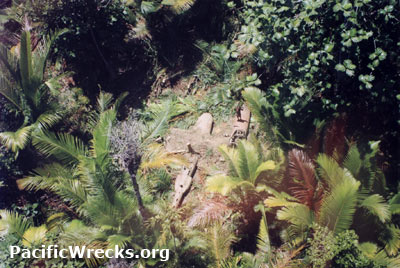|
|
||||||
|
|||||||
| Missing In Action (MIA) | Prisoners Of War (POW) | Unexploded Ordnance (UXO) |
| Chronology | Locations | Aircraft | Ships | Submit Info | How You Can Help | Donate |
|
| USAAF 5th AF 35th FG 39th FS  Widdis c1943  Richard Leahy 2000  Steve Cushman 2007 |
Pilot Captain Charles P. Sullivan (survived) Eureka, IL Force Landed September 20, 1943 at 12:00pm MACR none Aircraft History Built by Lockheed Aircraft Corporation (LAC) in Burbank, California. Delivered to the U. S. Army Air Force (USAAF) as P-38H-5-LO Lightning serial number 42-66851. Disassembled and shipped overseas and reassembled. Wartime History Assigned to the 5th Air Force, 35th Fighter Group, 39th Fighter Squadron. Assigned to pilot Charles P. Sullivan. Nicknamed "Mareelee II" on the left side of the nose, Mareelee named in honor of his wife and was the second he gave this name. Assigned squadron number 23 on the tail. On the left side of the nose below the cockpit was "O'Sullivan" in bold letters with two Japanese rising sun flags indicating missions flown. Both engines had shark mouths painted on the lower cowling and eyes on the upper cowling. Mission History On September 20, 1943 took off from 14-Mile Drome near Port Moresby piloted by Captain Charles P. Sullivan as one of sixteen P-38s on a mission to escort B-24 Liberators over Wewak. Sullivan was leading a four plane flight over the target at 24,000'. South of Wewak, he experienced engine trouble and was about to abort the mission. Turning back for base, his engine returned to normal and he rejoined the formation. Suddenly, he spotted an enemy fighter in his rear view mirror that opened fire before he could evade the gunfire. Charles Sullivan wrote in Faith Determination and a bit of Irish Luck: "Instinctively, I shoved the P-38 into a violent dive, dropping my auxiliary gasoline tanks as I went. It was then that I felt the shudder of bullets striking my plane. He had bit my left engine, which began spraying oil that started a smoky fire. I raced for the clouds below at speeds of nearly 500 miles per hour. The plane shuddered and shook from the strain. I looked back. I was pulling away from the Japanese fighter, but he was still stalking me. Oil began to spray on my windshield, obscuring my vision. I thought about parachuting right then, but instead I cut off the flaming engine and feathered the propeller, which stopped the fan and turned the blades so they would cut through the air with minimum drag. The fire in the left engine went out and my windshield cleared - but the stalker was still with me." Escaping into a cloud, Sullivan managed to escape from the enemy fighter. Turing towards base, he was flying on only one engine and without a radio. Around noon, he experienced problems with the right engine and force landed into the jungle, behind enemy lines. When he failed to return, he was officially listed as Missing In Action (MIA). Fate of the Pilot During the landing, Sullivan sustained a cut to his scalp, and spent the rest of the day cutting a path to the nearest tree line and spent the night under the cover of trees. On the third day, he left the crash site and attempt to walk towards friendly lines. After several days, he spotted a friendly plane but was unable to signal it. Locating native people in the jungle, he was taken to their village. Sullivan believed the natives were going to kill him and after an altercation, shot two of them and fled, evading angry villagers for two weeks. Finally, he encountered an Australian Army patrol and was taken to Dumpu. A small liaison plane arrived to rescue him, but it suffered an engine problem and flipped over on landed, but no one aboard was hurt. The next day, Sullivan boarded a C-47 Dakota at Dumpu Airfield and was transported back to Port Moresby rejoining his unit on October 20, 1943, exactly 30 days after force landing. Wreckage This P-38 remains in situ where it crash landed. The aircraft is located in a swamp area and submerged for roughly half the year from the flooding of nearby rivers that fills the interior with sediment and mud. Only during the dry season is it possible to trek to the wreckage or land a helicopter in the vicinity. In 1993 or 1994 Max Ammer was the first outside to re-locate the crash site near Brahman. Since then, other visitors have trekked to the crash site including several who claimed they had the right to salvage this aircraft but have not to date. References NARA World War II Army Enlistment Records - Charles P. Sullivan USAF Aerial Victory Credits Air Force Historical Research - Charles Sullivan USAF Serial Number Search Results - P-38H-5-LO Lightning 42-66851 PNG Museum Aircraft Status Card - P-38 Lightning Sullivan Ghost Wings "A Journey Through Headhunter Country" by M. Claringbould & R. Leahy Faith Determination and a bit of Irish Luck by Charles O'Sullivan 39th Fighter Squadron World War II Biographies - Charles O'Sullivan Injury Slight - Please Advise documentary by Josh Baxter Thanks to Max Ammer and Richard Leahy for additional information Contribute
Information Last Updated
|
P-38 Photo Archive |
| Discussion Forum | Daily Updates | Reviews | Museums | Interviews & Oral Histories |
|